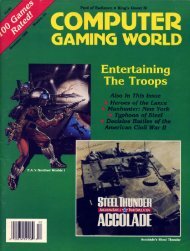The Gamer's Quarter - Issue #6 - TextFiles.com
The Gamer's Quarter - Issue #6 - TextFiles.com
The Gamer's Quarter - Issue #6 - TextFiles.com
Create successful ePaper yourself
Turn your PDF publications into a flip-book with our unique Google optimized e-Paper software.
to reinterpret and reconstitute many<br />
videogame songs with live instruments.<br />
Of course, modern videogames have<br />
much better sound quality, but the point<br />
still stands; even the best of videogame<br />
music can never match up to a live band.<br />
More importantly, the music of videogames<br />
is limited by the structure of<br />
videogames themselves. In the case of<br />
DD2 and many videogames, the songs<br />
must often effectively avoid having a<br />
beginning and an end, since they must<br />
loop throughout the level. Without a<br />
beginning or an end, the music is nothing<br />
more than a clip of sound, relegating it to<br />
the background. <strong>The</strong>re are other specific<br />
limitations to videogame music, but<br />
the important point is this: videogame<br />
music must conform to the limitations<br />
and requirements of the game first and<br />
foremost, not to the music itself. <strong>The</strong><br />
music of a videogame must reinforce<br />
the experience for the player, not simply<br />
be good music; and certain musical<br />
freedoms must be restricted in order to<br />
make the music work within the game.<br />
Structurally, videogame music can never<br />
be as <strong>com</strong>plex as a <strong>com</strong>plete song or<br />
<strong>com</strong>position.<br />
So, at least one aspect of videogames,<br />
the music, would seem to be limited in<br />
its breadth and potential. Presumably,<br />
another analogy could be made with the<br />
other creative aspects of videogames.<br />
<strong>The</strong> visuals can never be as <strong>com</strong>plex or<br />
as deep as a painting because the player<br />
must play in this visual space, and certain<br />
important objects and pieces of scenery<br />
have to take on functional importance,<br />
limiting the artist’s choices about how<br />
these parts of the game can look. Also,<br />
the story must not be<strong>com</strong>e too involved,<br />
or the writer risks limiting the player’s<br />
interactivity with the game; unexpected<br />
changes in plot that would normally<br />
be fine in a movie or novel often seem<br />
forced and out of the player’s control in a<br />
videogame, ruining the experience.<br />
So, the argument can be made that<br />
videogames naturally limit the individual<br />
aspects that make the game up, such as<br />
the musical, visual and narrative. But,<br />
is this necessarily a bad thing? <strong>The</strong>re is<br />
another medium that shares these same<br />
limitations: <strong>com</strong>ics.<br />
In <strong>com</strong>ics, the visuals and writing are<br />
restricted by the form of <strong>com</strong>ics; the<br />
writing must generally be simple and to<br />
the point in order to avoid distracting the<br />
reader from the action on the page, and<br />
the visuals must be divided into panels<br />
and simplified in order to give emphasis<br />
to characters and objects that are most<br />
important. Similarly, a videogame’s<br />
visuals, story and music are restricted by<br />
gameplay; all three must avoid being too<br />
<strong>com</strong>plex or intricate, so as not to get in<br />
the way of the player’s experience with<br />
playing the game.<br />
Comics, like videogames, have<br />
traditionally had trouble establishing<br />
themselves as a legitimate form of<br />
expression. Just like videogames,<br />
they were considered children’s entertainment,<br />
not worthy of the attention of<br />
mature readers. But, in recent years the<br />
status of <strong>com</strong>ics has steadily increased,<br />
to the point where many <strong>com</strong>ics and<br />
graphic novels are now considered<br />
modern classics. Of course, nothing<br />
significant about the form or structure<br />
of <strong>com</strong>ics has changed this time; rather,<br />
it was the opinions of the critics that<br />
changed, as they came to realize that<br />
<strong>com</strong>ics are in fact a medium capable of<br />
telling stories and conveying messages<br />
just as meaningful and enthralling as<br />
any novel, film or painting. Many had<br />
to realize that <strong>com</strong>ics were not merely<br />
the <strong>com</strong>bination of drawings that were<br />
more limited than paintings and writing<br />
that was more limited than novels, but<br />
instead a unique medium all its own.<br />
Comics add together limited aspects of<br />
many mediums to make an experience<br />
that is unique to <strong>com</strong>ics. If the visuals<br />
were too involved, or the writing too<br />
involved, the <strong>com</strong>ic would actually suffer;<br />
<strong>com</strong>ics benefit from having limited<br />
writing and visuals by <strong>com</strong>bining them to<br />
make something that is impossible with<br />
just one of the aspects. A <strong>com</strong>ic can tell<br />
a story in a way that neither a movie nor<br />
book ever could. 3<br />
We would argue that videogames<br />
are similar to <strong>com</strong>ics, in that they add<br />
together limited visuals, narrative,<br />
story, and images to make something<br />
that would be impossible in any other<br />
medium. Rather than create stories that<br />
are different from any other medium,<br />
as <strong>com</strong>ics do, they create an experience<br />
that is different from any other medium.<br />
<strong>The</strong> narrative, writing, visuals, sound,<br />
and music may be limited <strong>com</strong>pared to<br />
other art forms, but they <strong>com</strong>bine to<br />
together to make a gameplay experience<br />
that is something that no other art<br />
form can ever achieve. <strong>The</strong> art is in the<br />
<strong>com</strong>bination of these elements, however<br />
limited they are. One could go even<br />
further and say that they must be limited,<br />
in order to make a good videogame. In<br />
this way, videogames should be understood<br />
as their own medium. We cannot<br />
<strong>com</strong>pare videogames to paintings<br />
or musical <strong>com</strong>positions or writings,<br />
because it would be a mistake. Just as<br />
<strong>com</strong>ics have been misunderstood as<br />
juvenile and limited art forms, inferior<br />
to the individual art forms that they are<br />
<strong>com</strong>posed of, so too have videogames.<br />
But, so too should videogames not be<br />
viewed as an amalgam of artistic works<br />
inferior to their respective types, but<br />
as a medium unto itself, with its own<br />
degree of quality and its own possibilities,<br />
separate from other mediums.<br />
In this sense, a good videogame can be<br />
considered a good videogame, and also a<br />
good piece of art.<br />
3 Scott McCloud talks about this better than we ever could in Understanding Comics.<br />
28 <strong>The</strong> Gamer’s <strong>Quarter</strong> <strong>Issue</strong> <strong>#6</strong><br />
Medium Possibilities<br />
29

















